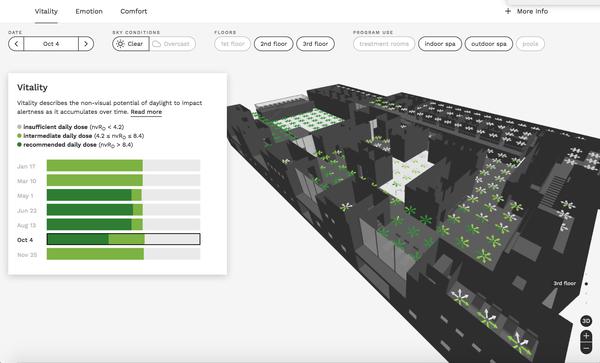New software can model natural light from the occupants' perspective

Marilyne Andersen, EPFL professor and Siobhan Rockcastle, who just achieved a postdoc at Laboratory of lntegrated Performance in Design, are the developers of OCUVIS © 2017 Alain Herzog
OCUVIS, a visualization software developed by a soon-to-be-launched EPFL spin-off, lets architects simulate 3D building models to assess the performance of natural light indoors. After specifying the ambient conditions, architects can view the visual and non-visual characteristics of the resulting natural light in their designs.
A building’s architecture should be designed to take advantage of the way natural light changes according to the season and time of day. While we can see daylight in a given space, the intensity, spectrum, and angle of sunlight can affect building occupants in ways that are hard to anticipate and that they may not even be aware of. For instance, the composition and intensity of light can sometimes have a calming effect, while other times it can have an alerting affect through the secretion of hormones triggered by the retina. OCULIGHT Dynamics, an upcoming EPFL spin-off, has drawn on the results of research completed at EPFL to quantify these effects and build up unique, in-depth expertise in this area. The company recently applied its know-how to develop a groundbreaking web visualization software that enables architects to predict how daylight will impact building occupants based on three criteria: comfort, in terms of glare avoidance; vitality, in terms of non-visual light exposure over the course of a day; and emotion, in terms of the spatial composition and fluctuations of light.

Simulating natural light from the occupants’ perspective
The process begins with a 3D computer model of a planned building and its geographic position. From there, the architect can specify the ambient weather conditions and see how the resulting daylight would be perceived by building occupants at eye level from a variety of points within the building. Using OCUVIS to compute and visualize the results, an architect can then change settings related to the time of day or year, sky condition, and location in the building and see how the dynamics of sunlight, weather, and space impact occupant well-being across a handful of factors.
At each point within the building, a cluster of arrows – each representing a viewpoint direction from a given spot – appear in different colors indicating whether the light at that point is conducive to calm or excitement, if it poses a long-term health risk, or if there is a possibility of visual discomfort. The light at a given point could be vibrant, energetic and auspicious for an occupant’s health if he is looking towards a window, for example, but have the opposite effect if the occupant has his back to the window or if it’s a grey winter day. Architects can use such information to improve their building designs so as to enhance occupants’ visual comfort and well-being. Of course, the ideal daylight design for a given space also depends on how that space will be used by its inhabitants.
A new type of receptor attuned to circadian rhythms
Three researchers from EPFL’s Interdisciplinary Laboratory of Performance-Integrated Design (LIPID) teamed up to develop the visualization platform and computational models describing the underlying performance factors – and to set up their new business, OCULIGHT Dynamics. The budding company will offer highly specialized, pioneering consulting services provided by its three founders: Marilyne Andersen, an EPFL professor and head of LIPID; and Siobhan Rockcastle and Maria Amundadottir, who both completed their PhDs at LIPID. Rockcastle has since become a tenure-track professor in the US at the University of Oregon, while Amundadottir works as a research engineer in Iceland.
The models used to quantify the characteristics assessed by their software have been published in numerous journal articles and two dissertations. One journal paper described how humans perceive different lighting environments; the findings of this study were used “to determine what percentage of people would consider a given environment calm or exciting based on the lighting composition,” says Rockcastle. The responses of subjects participating in that study were used to develop an algorithm that is used as prediction model for the OCUVIS software.
Light’s non-visual characteristics – still little-known by most people – has been found to have a measurable effect on many aspects of our health. “It wasn’t too long ago that scientists discovered a new type of photoreceptor, called ipRGCs, in the human eye. These receptors regulate our internal clock to the external light dark cycle and respond directly to bright light, impacting alertness and wellbeing,” says Amundadottir. Research has shown that characteristics having the greatest impact on our non-visual system include the intensity of light, the timing of exposure, and its spectral distribution (e.g., color, blue light is the most effective).
The three EPFL researchers obtained a Venture Grant from the InnoSeed ENAC program that together provided funding for the key development steps of their visualization software, which is already online. These steps included creating features that let architects interactively visualize the performance of light on human well-being in a given space, compare different design options and performance measures, and evaluate their designs against applicable lighting standards. More generally, it lets architects incorporate well-being-related factors like occupant health, comfort and emotion alongside conventional evaluation criteria.
